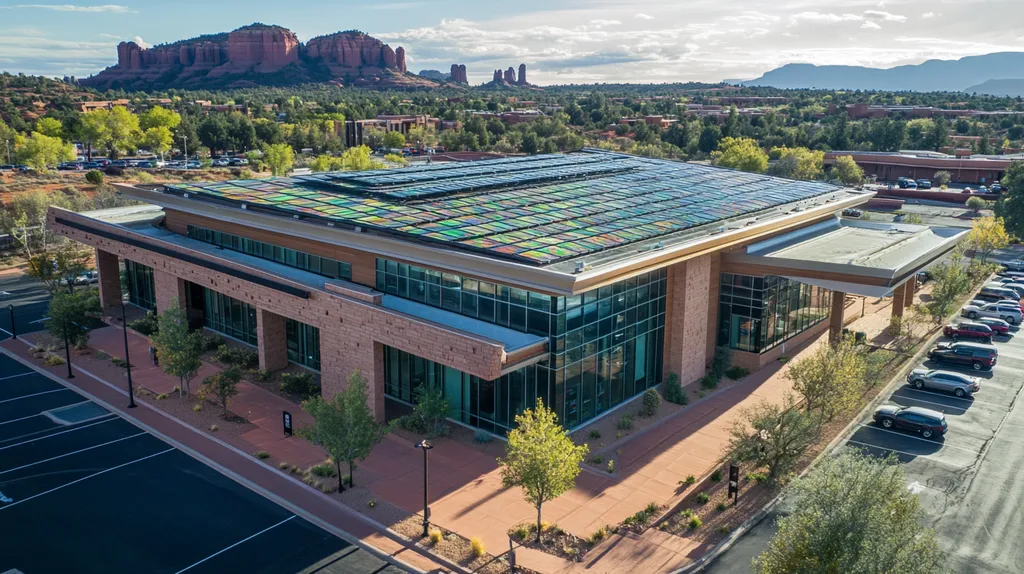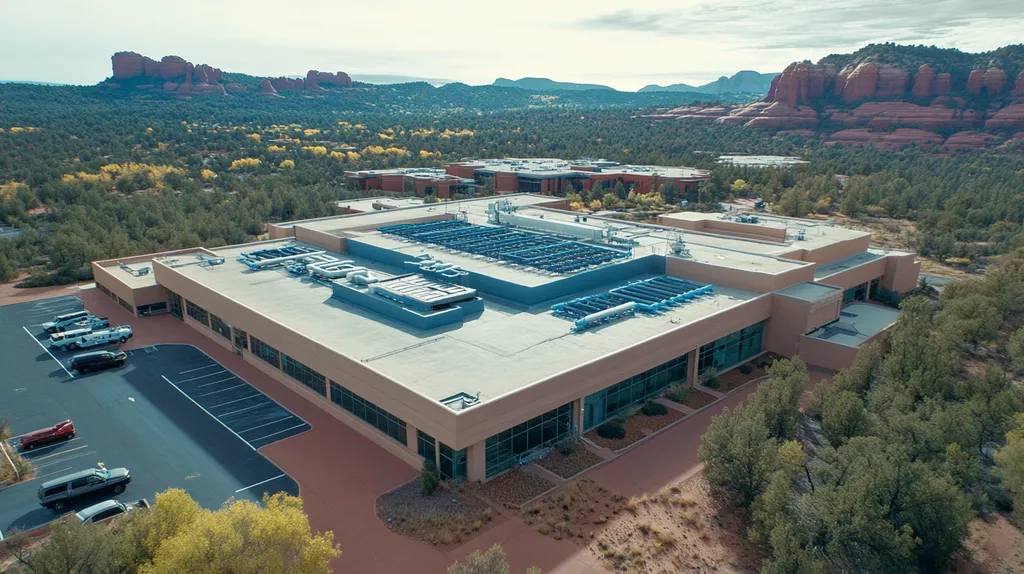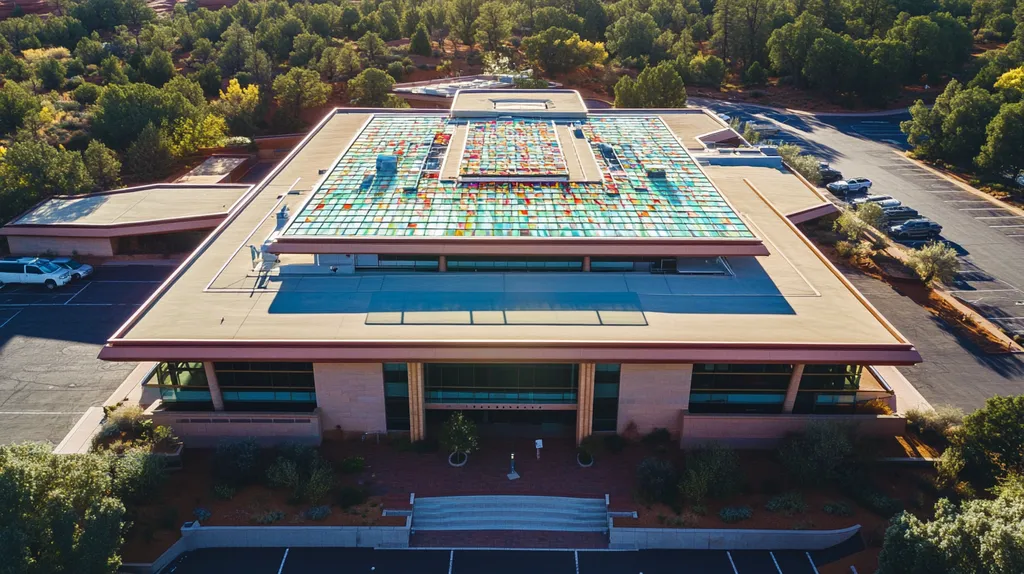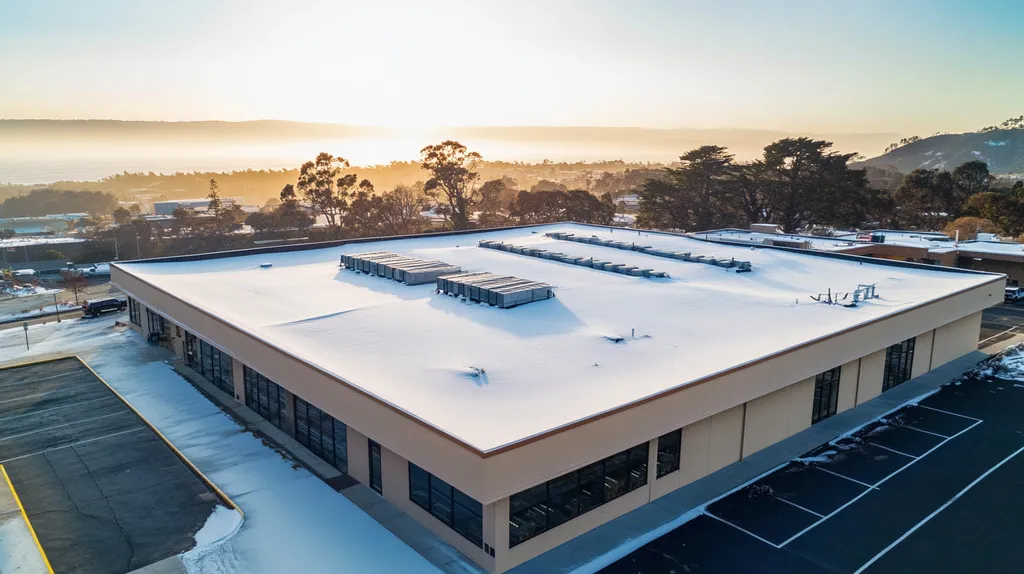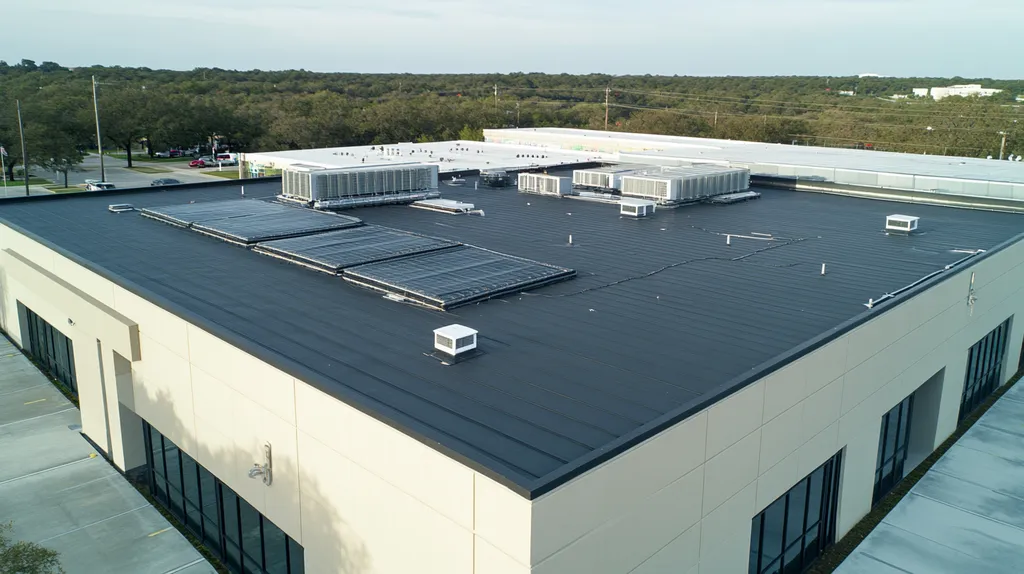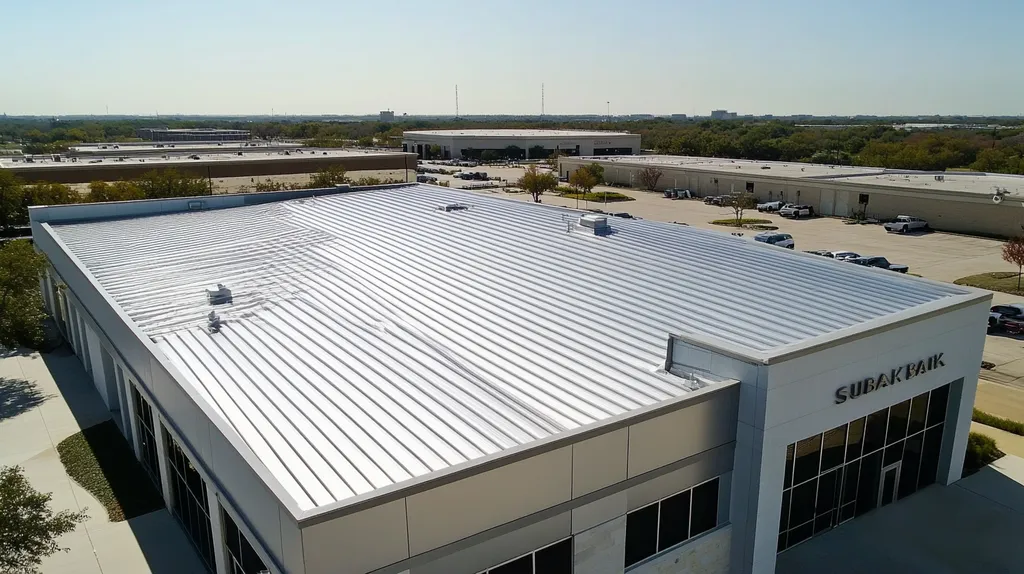Industrial roof coatings play a pivotal role in protecting billions of dollars worth of commercial and industrial infrastructure, yet studies show that up to 40% of coating failures stem from improper material selection and application.
The challenge lies not just in choosing the right coating, but in understanding how different materials interact with various substrates and environmental conditions.
This comprehensive guide examines the critical aspects of industrial roof coating applications across diverse materials, from preparation and implementation to long-term maintenance and performance optimization, helping facility managers make informed decisions that protect their investments.
SECTION 1: FUNDAMENTAL CONCEPTS
Investing in industrial roof coatings is crucial for property owners looking to extend the life of their roofing systems. These coatings not only contribute to lower maintenance costs but also enhance energy efficiency, benefiting both the budget and the environment. However, choosing the right coating for various materials involves navigating a complex array of options that can significantly impact overall facility performance. This section delves into the types of industrial roof coatings, along with their benefits, limitations, and compatibility with different roofing materials.
Types of Industrial Roof Coatings
Industrial roof coatings come in several key types, each tailored for specific materials and applications. Acrylic coatings are favored for their UV resistance and versatility, making them suitable for metal and single-ply roofing systems. On the other hand, polyurethane coatings stand out for their exceptional durability and chemical resistance, making them ideal for roofs subjected to severe environmental conditions.
Silicone coatings excel in water resistance, particularly for flat or low-slope roofs, although they can become slippery when wet. Asphalt-based coatings are commonly employed for built-up roofs, providing a budget-friendly solution with beneficial thermal properties. Understanding these types empowers property owners to make informed choices aligned with their specific roofing requirements.
Choosing the right coating not only enhances roof longevity but also boosts thermal performance, resulting in energy savings. Each coating type requires unique application methods and has its own environmental implications, so grasping these differences is vital for effective decision-making.
For example, applying acrylic on a metal roof can significantly enhance resistance to rust and UV damage. Conversely, using silicone in an unsuitable environment may lead to premature degradation, underscoring the importance of ensuring material compatibility.
Benefits and Limitations of Each Coating
Every type of industrial roof coating comes with its own set of benefits and limitations. Acrylic coatings are flexible and user-friendly but may require more frequent reapplications. They excel in UV resistance, extending the roof’s life, though they offer limited defense against standing water.
Polyurethane coatings deliver strong protection against chemicals and wear, making them excellent for industrial environments. However, they can be pricier and must be applied carefully to avoid issues with degradation. Silicone coatings provide superb water resistance, yet their higher initial cost can be a deterrent for some property owners.
Meanwhile, asphalt-based coatings are attractive due to their affordability and reasonable insulation properties. Yet, they often crack under severe weather conditions, limiting their effectiveness in harsh climates. Weighing these pros and cons is essential for making a sound investment.
Ultimately, understanding each coating’s advantages and drawbacks equips facility managers to align their goals with the most suitable products.
Compatibility with Roofing Materials
The compatibility of roof coatings with various roofing materials is a pivotal factor in determining their effectiveness. Acrylic coatings bond well with metal and modified bitumen roofs but may struggle with certain types of single-ply membranes.
Polyurethane offers strong adhesion across different surfaces; however, it requires meticulous surface preparation for optimal results. While silicone coatings are excellent for low-slope roofs, they may not adhere well to gravel or granular surfaces due to potential adhesion issues.
Ashalt-based coatings primarily suit built-up roofs but can cause deterioration if applied over newer materials like TPO or PVC. Recognizing these compatibility challenges allows property owners to avoid costly mistakes, ensuring their roof coatings perform at their best.
In summary, comprehending the relationship between roof coatings and their materials is essential in maximizing both the longevity and efficacy of roofing systems. Ensuring compatibility not only enhances performance but also mitigates the risks associated with unforeseen issues.
SECTION 2: SYSTEM COMPONENTS
Understanding the components of an industrial roof coating system is vital for property owners and facility managers alike. When roofing materials and substrates are improperly selected, the performance and longevity of coatings can suffer dramatically, with studies indicating a potential drop in effectiveness of over 30%. Making informed decisions in this area is essential to safeguard valuable investments. This section delves into the types of roofing materials, the properties of coatings, and the necessary adhesion mechanisms needed for a successful application.
Roofing Materials and Substrates
The choice of roofing material is paramount in determining how effectively industrial roof coatings will perform. Common substrates such as metal, asphalt, concrete, and single-ply membranes each have their own unique characteristics that can influence coating adhesion and performance under different environmental conditions.
For instance, metal roofs often need specific primers to ensure proper adhesion. Additionally, asphalt roofs require thorough cleaning to eliminate contaminants before any coating is applied. For concrete roofs, coatings with strong UV resistance are essential to prevent sunlight-induced degradation.
By understanding the nuances of these materials, property owners can make smarter choices regarding coatings, avoiding costly mistakes and boosting the overall lifespan of the roofing system. The right combination of materials not only extends roof life but also yields substantial energy savings.
Ultimately, careful selection of roofing materials sets the foundation for optimal performance of the entire coating system, reinforcing durability and waterproofing capabilities.
Coating Properties and Characteristics
The performance of industrial roof coatings can vary significantly based on their inherent properties, making it crucial for decision-makers to understand these attributes. Key characteristics such as UV resistance, flexibility, and water impermeability play a major role in how a coating performs when faced with environmental stressors.
For example, high UV-resistance coatings are critical for roofs that experience constant exposure to sunlight, as they can reduce surface temperatures by up to 20°F when subjected to direct sunlight at 85°F. Flexibility in coatings allows them to expand and contract with temperature changes, helping prevent cracking and extending service life.
Furthermore, selecting coatings that are appropriate for the facility’s operational environment is essential. Coatings designed for harsh industrial settings must endure exposure to chemicals and heavy foot traffic, differing substantially from standard options.
By thoroughly analyzing coating characteristics, facility managers can enhance both the performance and longevity of their roofing systems.
Adhesion and Bonding Mechanisms
Proper adhesion and bonding mechanisms are critical for the successful application of roof coatings. The way a coating bonds to a substrate significantly influences the overall success of the roofing system. Key factors such as surface cleanliness, ambient temperature, and application technique are essential to this process.
Surface preparation is vital for achieving strong adhesion. Contaminants such as oil, dirt, and moisture can severely weaken the bond, leading to early failures of the coating. It’s best practice to test for these contaminants before the application process.
Moreover, various chemical adhesives are designed for specific substrates, enhancing the bonding process. For instance, water-based coatings may perform excellently on certain membranes, while solvent-based options might be more suitable for metal roofs.
Understanding these bonding mechanisms allows property owners to make informed decisions, ultimately reducing the risk of delamination and enhancing the effectiveness of their coating systems.
SECTION 3: IMPLEMENTATION METHODS
Effective application of industrial roof coatings is crucial for ensuring longevity and peak performance. Neglecting proper preparation or utilizing inadequate methods can result in early failures, potentially costing property owners thousands in unnecessary repairs. Alarmingly, studies show that up to 30% of coating failures originate from poorly prepared surfaces. This section explores essential implementation methods, including preparation and cleaning, precise application techniques, and effective curing processes.
Preparation and Surface Cleaning
The success of a roof coating project hinges on thorough surface preparation and cleaning. Overlooking this crucial step can drastically diminish adhesion and overall performance. Property owners must prioritize removing dirt, debris, and any previous coatings that could interfere with the new application.
Different roofing materials demand specific cleaning techniques. For instance, metal roofs often require pressure washing with detergent, while TPO and PVC membranes may benefit from specialized cleaning agents. Ensuring that surfaces are completely dry is vital before proceeding with the application.
Additionally, addressing any rust or deterioration on metal roofs is essential. Applying a rust-inhibiting primer can thwart future corrosion and enhance the overall durability of the coating. Adequate surface preparation not only reduces the risk of delamination but also boosts the effectiveness of the coating.
Investing time and resources in this foundational step not only extends the life of a coating but also ensures optimal performance, ultimately yielding the best return on investment.
Application Techniques and Tools
The methodical application of roof coatings is fundamental to achieving optimal results and utilizing the right tools is essential. Common techniques include using brushes, rollers, or spray equipment, each offering unique benefits in how the material applies and cures.
For large areas, spray applications are often the most efficient and provide consistent coverage. However, brushes are ideal for intricate sections or necessary touch-ups. Property owners should consult with professionals to identify the most effective application method tailored to their specific roofing material.
Environmental conditions during application significantly affect outcomes. Temperature and humidity can impact drying times and overall performance. Ideally, coatings should be applied within a temperature range of 50°F to 90°F, and it’s crucial to avoid heavy winds or precipitation during the process.
Finally, utilizing high-quality tools and ensuring that workers are adequately trained can substantially enhance the coating’s durability, helping property managers sidestep long-term complications.
Curing and Drying Processes
Comprehending curing and drying processes is essential for maximizing coating performance. Curing refers to the chemical transformation that occurs as the coating hardens and bonds with the substrate, and this process varies based on the type of coating selected.
Most liquid coatings necessitate adequate time to cure fully. Hurrying through this process can result in soft films that are highly susceptible to environmental damage. For instance, water-based coatings may require at least 24 hours to cure, while others could take several days.
Moreover, external factors such as temperature and humidity levels greatly influence drying times and the efficacy of the bonding process. Facilities managers should monitor these conditions and schedule applications carefully to achieve the best possible outcomes.
Proper curing and drying are vital for prolonging the lifespan and performance of roof coatings, ensuring that property investments remain well-protected for years ahead.
SECTION 4: MAINTENANCE REQUIREMENTS
Ensuring the longevity of industrial roof coatings through proper maintenance is not just advisable—it’s essential. Industry statistics show that neglecting routine upkeep can reduce a coated roof’s lifespan by as much as 30%. Regular inspections, prompt repairs, and preventative strategies are vital to maximize performance and protect the valuable investment in your facility.
Regular Inspection and Monitoring
Conducting regular inspections is key to catching potential problems before they worsen. Facility managers should aim to schedule these assessments at least twice yearly—preferably in the spring and fall. Inspections should concentrate on vulnerable areas, such as seams, flashings, and any other spots prone to wear.
During these evaluations, be on the lookout for signs of deterioration like bubbles, cracks, and discoloration. Early identification can lead to simple repairs, ultimately saving costs in the long run. To enhance monitoring efficiency, consider utilizing drones or infrared technology for accurate assessments.
Documenting inspection findings is vital for maintaining a comprehensive history of the roof’s condition. This record helps track changes over time and informs future maintenance decisions and budgeting. By establishing a proactive inspection schedule, facilities can fend off significant damage and prolong the roof’s useful life.
Repair and Touch-Up Procedures
Prompt repairs are essential to uphold the integrity of industrial roof coatings. When damages—such as tears or cracks—are found during inspections, it’s crucial to act swiftly. Left untreated, minor damage can escalate into serious issues like leaks, leading to higher repair costs.
Any touch-up work should align with the manufacturer’s guidelines to ensure compatibility with existing coatings. Using the correct materials and methods is key to achieving a secure seal and maintaining the coat’s functionality. For more extensive damage, bringing in a professional experienced in industrial coatings can bring significant advantages.
Addressing repairs promptly is not just a best practice; it’s necessary for safeguarding the roof’s performance and extending its lifespan. Investing in timely interventions facilitates better long-term outcomes and minimizes disruptions to facility operations.
Preventative Measures Against Damage
Implementing preventative measures can significantly reduce the risk of roof damage. Central to a solid maintenance routine is keeping the roof clear of debris, which can trap moisture and lead to deterioration. A clean surface also makes subsequent inspections simpler and more effective.
Effective drainage is another crucial preventative strategy. Ensuring gutters and downspouts are free of clogs can prevent water pooling, which could compromise the coating’s integrity over time.
Training staff on roof safety protocols is equally important. All personnel accessing the roof should be informed about the appropriate procedures to avoid creating damage while carrying out routine tasks.
By adopting a proactive maintenance strategy that incorporates these preventative measures, facilities can save substantial costs and maintain the functionality of their industrial roof coatings. Investing time and resources in these efforts will yield long-lasting benefits for the building and community alike.
SECTION 5: PERFORMANCE METRICS
When selecting roof coatings, industrial property owners and facility managers face critical choices that can impact their bottom line and environmental footprint. An ineffective coating can result in energy loss, leading to inflated operational costs. Research reveals that coatings, when correctly applied, can cut energy consumption by up to 30%. This section evaluates essential performance metrics: energy efficiency, durability, and resistance to weather conditions and UV rays.
Energy Efficiency and Cost Savings
Energy efficiency is vital for any industrial roofing system. Quality roof coatings reflect sunlight, which significantly lowers indoor temperatures. This reduction can lead to remarkable decreases in air conditioning expenses, translating to tangible savings over time.
Facility managers should seek reflective coatings with a Solar Reflective Index (SRI) of 80 or higher. These surfaces can help facilities save anywhere from 15% to 25% on cooling costs annually. Investing in these coatings not only benefits finances but also aligns with the commitment to reducing environmental impact.
In addition, energy-efficient coatings contribute to longer roof lifespans. A well-maintained roof reduces stress on HVAC systems, extending their lifespan and presenting further financial advantages. This decision is ultimately about investing in a more sustainable future for the facility and the planet.
Durability and Lifespan Evaluation
Durability is a non-negotiable metric when assessing industrial roof coatings. Coatings that resist cracking, peeling, or fading can significantly prolong the life of the roofing system. For instance, polyurea coatings can last upwards of 20 years with minimal maintenance required.
It is essential to examine the coating’s material composition closely. Coatings such as those based on silicone provide excellent waterproofing and maintain flexibility amid temperature fluctuations, enhancing overall durability. This resistant nature minimizes the need for emergency repairs, allowing facilities to dedicate resources to their primary operations instead.
By focusing on durability and lifespan, property owners can transform potential challenges into long-term solutions, effectively preserving both their roofs and budgets.
Weather Resistance and UV Protection
Weather resistance is another pivotal performance metric that dictates a roof’s integrity. Coatings designed to endure severe weather—such as intense rain, strong winds, and extreme temperatures—are crucial for protecting assets from damaging forces.
Coatings with built-in UV protection are engineered to withstand sun damage, preventing premature aging and degradation. For example, acrylic coatings offer substantial UV resistance, ensuring that the roof surface remains intact over extended periods.
Furthermore, effective weather resistance safeguards against leaks and water intrusion, which can lead to mold growth and serious structural issues. This protection ultimately enhances operational efficiency by minimizing downtime. Selecting coatings with tested weather-resistant features can effectively shield industrial investments from nature’s harshest elements, ensuring both longevity and reliability.
SECTION 5: PERFORMANCE METRICS
Choosing the right roof coatings is not just a matter of aesthetics; it significantly impacts a facility’s operational efficiency and environmental footprint. An ineffective coating can lead to significant energy losses and inflated costs. Research indicates that with proper application, roof coatings can reduce energy consumption by as much as 30%. This section discusses vital performance metrics: energy efficiency, durability, and resistance to weather conditions and UV rays.
Energy Efficiency and Cost Savings
Energy efficiency stands as a cornerstone for any successful industrial roofing system. High-quality roof coatings reflect sunlight, leading to reduced indoor temperatures and lower air conditioning costs. This significant reduction can generate substantial savings over the long term.
Facility managers should prioritize coatings achieving a Solar Reflective Index (SRI) of 80 or higher. Facilities employing these coatings often experience cooling cost savings of 15%-25% annually, making sustainability a financially smart choice.
Moreover, energy-efficient coatings can extend the lifespan of roofs by relieving stress on HVAC systems. A well-maintained roof contributes to longer HVAC longevity, thus generating further financial advantages.
In essence, investing in energy-efficient coatings is not merely a cost—it’s a strategic decision that delivers considerable long-term savings while fostering a more sustainable future for facilities and the environment.
Durability and Lifespan Evaluation
Durability is a non-negotiable performance criterion for industrial roof coatings. Coatings that stand up to cracking, peeling, or fading can significantly enhance the longevity of a roofing system. For example, polyurea coatings can endure for over 20 years with minimal maintenance.
An in-depth examination of the coating’s composition is crucial. For instance, silicone-based coatings not only offer excellent waterproofing features but also retain flexibility in fluctuating temperatures, which bolsters their durability.
Furthermore, investing in robust coatings minimizes the need for costly repairs due to potential structural damage. Facilities that choose durable roofing solutions encounter fewer disruptions and can better allocate resources toward their primary operations instead.
By focusing on durability and lifespan, property owners can convert potential headaches into long-term solutions that effectively safeguard both their roofs and budgets.
Weather Resistance and UV Protection
Weather resistance is another vital metric directly influencing a roof’s integrity. Coatings engineered to withstand harsh weather—such as heavy rains, strong winds, and extreme temperatures—are essential for protecting valuable assets.
Coatings designed with built-in UV protection shield surfaces from sun damage, which can cause premature wear and degradation. For instance, acrylic coatings possess excellent UV resistance, ensuring the roof’s integrity remains intact for many years.
Additionally, effective weather resistance prevents leaks and potential water intrusion that might lead to mold growth and structural issues. This proactive measure not only minimizes downtime but also boosts overall operational efficiency.
Choosing coatings with established weather-resistant properties effectively protects industrial investments from nature’s harshest elements, thereby ensuring both longevity and reliability.
Looking Ahead
As commercial and industrial facilities face mounting pressure to reduce energy costs while extending roof lifespans, proper coating selection and application have never been more critical.
Industry data shows that well-implemented coating systems can reduce energy consumption by up to 30% while extending roof life by 15-20 years, representing millions in potential savings across the commercial sector.
The success of any industrial roof coating project depends on understanding material compatibility, following proper preparation protocols, and maintaining regular inspection schedules.
By embracing these evidence-based best practices, facility managers can protect their investments while contributing to a more sustainable built environment for future generations.
The future of industrial roofing lies in smart coating choices that balance performance, sustainability, and long-term cost effectiveness.
FREQUENTLY ASKED QUESTIONS
Q. Why is industrial roof coating important for commercial roofs?
A. Investing in industrial roof coatings helps extend the life of roofs. They reduce maintenance costs while enhancing energy efficiency. This is not only beneficial for your budget but also positively impacts the environment.
Q. How do roofing materials affect industrial roof coatings?
A. Each roofing material interacts uniquely with coatings, influencing adhesion and performance. For example, metal roofs may require specific primers for proper bonding, while asphalt roofs need thorough cleaning before application to ensure effectiveness.
Q. What preparation is needed before applying roof coatings?
A. Surface cleaning is crucial for effective coating application. Remove dirt, moisture, and any previous residues. This step ensures better adhesion and ultimately enhances the performance and lifespan of the roofing system.
Q. How can regular maintenance extend the life of industrial roof coatings?
A. Routine inspections help identify early issues, preventing costly repairs. Addressing minor damage quickly ensures the roof maintains its integrity and extends its lifespan, minimizing disruptions and preserving your investment effectively.
Q. What energy savings can be anticipated with proper roof coatings?
A. High-quality coatings enhance energy efficiency by reflecting sunlight, resulting in lower indoor temperatures. Facilities can expect up to 25% savings on cooling costs annually, contributing to both financial and environmental benefits.
Q. How do weather conditions affect roof coating performance?
A. Extreme weather can damage rooftops if coatings lack proper resistance. Products designed for weather resilience help prevent leaks and prolong roof integrity, ensuring the facility remains protected against harsh outdoor conditions.
Q. What are the best practices for applying industrial roof coatings?
A. Proper application techniques, including using the right tools and conditions, are essential. Following manufacturer guidelines ensures a successful application, maximizing the effectiveness and longevity of the roof coating.

